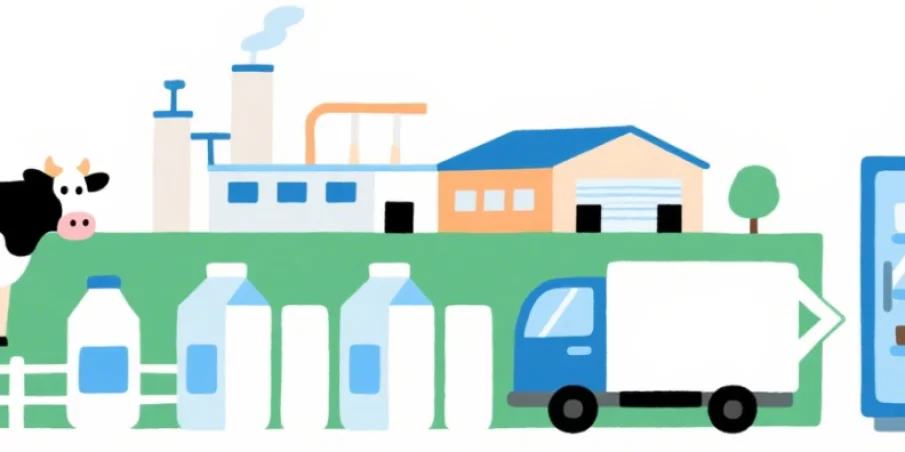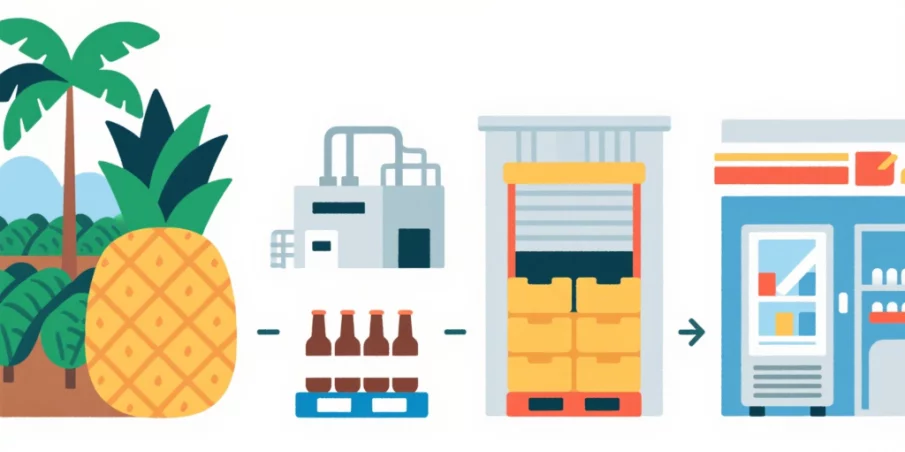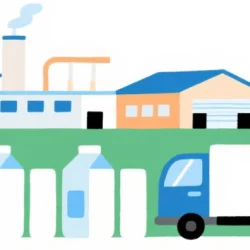Best Supply Chain Management Software for Food & Beverage

Short shelf lives, batch recalls, allergen risks, promotional spikes, and strict record-keeping make the food and beverage (F&B) supply chain a different world from most others. If you’re looking for the best supply chain management software for food & beverage, you don’t just need generic planning and inventory tools. You need systems that can follow ingredients from supplier lot to finished goods, respect expiry dates at every stop, help you pass audits without sweat, and keep warehouses humming even when demand whipsaws. This guide breaks it all down in plain English so you can pick software that fits how you actually make, move, and sell food.
What “supply chain management software” means in F&B
For many industries, supply chain software stops at purchasing and shipping. In F&B, the job is bigger. The right platform connects forecasting, purchasing, production scheduling, quality checks, warehousing, transportation, and—crucially—traceability. Imagine being able to pull up a finished lot, click once to see every raw ingredient lot that went into it, and then click again to see which customers received which cases. That’s the kind of end-to-end visibility that protects brands and makes recalls targeted rather than chaotic.
Good F&B systems also understand recipes and yields. You may start with 100 kilos of tomatoes, but simmering reduces volume; brines change weights; packaging creates by-products. The software should track every transformation so your inventory and costs stay real. And because retailers, foodservice customers, and regulators expect accurate records on demand, your system should produce clean electronic reports without last-minute spreadsheet gymnastics.
If that sounds like a lot, you’re not wrong. The good news is there are mature platforms built for these wrinkles. Below you’ll find the best supply chain management software for food & beverage, grouped by what each does best.
How to choose without getting overwhelmed

If you have been following the best supply chain news websites, you might easily get overwhelmed. How to avoid getting overwhelmed with supply chain news? Start with your biggest bottleneck. Are stockouts and waste killing margins? Is your warehouse struggling to follow FEFO rules? Do audits send everyone scrambling? Zeroing in on the main pain point helps you choose a platform whose strengths match your day-to-day reality.
Next, think about planning versus execution. Planning tools improve forecast accuracy and production schedules so you make the right things in the right amounts. Execution tools shine in the plant and warehouse, making sure the plan becomes reality with lot controls, quality checks, and smart picking. Some platforms do both, but most still lean one way or the other. Picking a tool aligned with your main constraint makes adoption smoother and payback faster.
Finally, consider your ecosystem. If you already run on Microsoft, you may value tight links to Azure, Power BI, and Office. If you’re scaling fast with multiple subsidiaries, you may want a unified cloud suite that handles finance and inventory together. And if you’re retail-heavy, the features that cut fresh food waste and handle promotions will matter more than deep shop-floor control. With those questions in mind, here are the stand-out options.
Best supply chain management software for food & beverage (by scenario)
Infor CloudSuite Food & Beverage — built end-to-end for the industry
Infor CloudSuite Food & Beverage is one of the most complete, industry-specific suites you can buy. It’s designed for process manufacturers from bakery to beverage, with recipe/formula control, allergen and label management, batch and expiry tracking, and quality workflows that plug directly into production. Because it’s an industry cloud, updates roll in without the drama of big upgrades, and the data model already speaks the language of catch weights, variable yields, and multi-site distribution. If your plan is to simplify your stack rather than stitch multiple products together, Infor’s breadth is compelling. It’s a strong fit for mid-to-large producers who want finance, manufacturing, planning, and compliance in one place.
Aptean Food & Beverage ERP — compliance-first traceability done right
Aptean Food & Beverage ERP focuses squarely on food and beverage realities. If top-of-mind worries include passing audits, handling targeted recalls, and organizing supplier documentation, Aptean’s traceability features are a highlight. You can track ingredients across transformations, attach supplier and quality documents to lots, and retrieve what auditors ask for without hunting through shared drives. The interface feels designed for everyday users rather than only power admins, which makes adoption simpler for teams juggling production and quality responsibilities.
Oracle NetSuite — one cloud suite for fast-growing brands
NetSuite for Food & Beverage combines financials, inventory, order management, and manufacturing with food-specific editions. The appeal is straightforward: a single cloud platform that keeps multi-entity accounting, demand planning, purchasing, and fulfillment in sync as you scale. For brands selling through multiple channels, the unified view of orders and stock across locations is handy. Add in built-in workflows for lot tracking and recalls, and NetSuite makes a practical choice for fast-growing manufacturers and distributors that want one login instead of a mosaic of separate tools.
Microsoft Dynamics 365 Supply Chain Management — best fit for Microsoft-centric companies
If your business already runs on Microsoft 365, Azure, and Power Platform, Dynamics 365 Supply Chain Management slots neatly into that world. You get real-time visibility across planning, production, and warehousing; native connections to Power BI for analytics; and a partner ecosystem that covers industry add-ons like catch-weight handling or trade promotions. For companies standardizing on Microsoft, the benefit is a common data backbone and familiar user experience, which often shortens training and speeds up cross-department collaboration.
Blue Yonder — AI-driven planning when accuracy is your headache
When your chief problem is forecast accuracy and “we keep running out of the wrong things,” planning depth matters more than anything else. Blue Yonder Supply Chain Planning is built for that, using machine learning to sense demand signals, align supply, and recommend adjustments before shortages or overages hit. Food and beverage producers value how it connects demand planning with production and inventory positioning, so schedules and stock levels can flex with promotions, seasonality, and supplier hiccups. If you already have ERP covered but want to cut waste and stockouts with better plans, Blue Yonder belongs on your shortlist.
RELEX Solutions — tailor-made for grocers and food-led retailers
Fresh items are tricky. Promotions swing demand; shelf space is tight; and waste is expensive. RELEX for Grocery Retailers is purpose-built for retailers and wholesalers living that reality. It unifies forecasting, replenishment, pricing and promotions, and store operations, with proven results in reducing spoilage and improving on-shelf availability. If your business includes retail stores, convenience outlets, or a wholesale network where promotional calendars and local patterns drive demand, RELEX provides planning logic that feels like it was made for your world.
Manhattan Active Warehouse Management — rock-solid distribution execution
If your bottleneck sits in the distribution center, Manhattan Active Warehouse Management is the heavy hitter for F&B. It’s cloud-native and versionless, which means upgrades land without the downtime that can otherwise wreak havoc on refrigerated operations. The WMS handles traceability in the DC, orchestrates automation and labor, and respects the shelf-life rules you set, so FEFO picking and recall holds work as intended. Foodservice distributors, large grocers, and multi-site DC networks often turn to Manhattan when they need execution they can trust across thousands of daily picks.
Plex (Rockwell Automation) — plant-floor visibility and traceability
Plex for Food & Beverage focuses on the manufacturing core: connecting machines, people, and quality so every step is traceable. If your headaches include changeovers, ingredient genealogy, and capturing quality checks as production runs, Plex’s shop-floor DNA pays off. It helps you track batches from receiving through processing and packaging, then ties that history back to finished goods so audit questions are answered with a few clicks. For producers who want “glass-box” visibility into what actually happened on the line, Plex is a strong fit.
Epicor — pragmatic control for midsize food and beverage manufacturers
Epicor for Food & Beverage is a sensible choice for manufacturers who want solid batch/lot control, embedded quality, and production planning without the overhead of a giant suite. It’s well-suited to mid-market operations making cooked or processed foods, specialty beverages, and similar products where recipe control and compliance are everyday concerns. The platform’s manufacturing heritage shows up in practical details like traceability workflows, audit logs, and shop-floor integration that help teams keep lines running smoothly.
What to look for (and why it matters)

Lot and expiry control are non-negotiable because they shape everything else. Without reliable batch tracking you can’t perform a clean recall; without expiry logic in your warehouse you end up shipping short-dated inventory or writing off product. The best supply chain management software for food & beverage makes this automatic rather than heroic. You should be able to set shelf-life rules, assign allergens, and trace forwards and backwards instantly.
Recipe and yield management come next. In real kitchens and plants, ingredients don’t behave like neat, fixed quantities. Moisture, cooking, and shrink introduce variance. Good systems let you define formulas with alternates and capture actual yields, so planners and buyers work from the truth, not guesses. When yields shift, the plan should flex and purchasing should adjust so you aren’t short on a critical input or sitting on expensive overstock.
Planning tools earn their keep by cutting waste and stockouts at the same time. That sounds like a magic trick, but it’s mostly about better signals and faster decisions. Machine-learning forecasts that incorporate promotions, weather, and local patterns help you make the right amount. When plans connect tightly to production and inventory, changes flow through without manual rework. If your issues are demand spikes and “oops, we made too much,” invest in planning first.
Warehouse execution ties it all together. Even perfect plans fall apart if the DC can’t pick FEFO or if recall holds don’t lock the right pallets. A strong WMS designed for perishables understands temperature zones, compliance needs, and lot holds without you building custom band-aids. When the DC honors your rules, your fill rate, waste, and customer complaints all move in the right direction.
Which option fits your situation?
If you want an F&B-specific ERP that covers finance through production with deep traceability, Infor CloudSuite Food & Beverage and Aptean Food & Beverage ERP are stand-outs. If you’re scaling quickly and want one cloud suite across accounting, inventory, and manufacturing, Oracle NetSuite is very compelling. If your company is standardizing on Microsoft, Dynamics 365 Supply Chain Management keeps everything in the same ecosystem, from analytics to collaboration.
If you already have ERP in place but forecasts and plans are the problem, Blue Yonder brings the most planning muscle to the table. If you’re a retailer, wholesaler, or hybrid brand with grocer-like dynamics, RELEX is purpose-built for your world. If your DC is where orders go wrong, Manhattan Active WMS brings the execution reliability you need. And if plant-floor traceability is your top priority, Plex and Epicor both offer practical control with manufacturing-friendly workflows.
Implementation tips that keep projects sane
Start with clean data. Standardize product codes, allergen flags, shelf-life rules, and pack sizes before go-live. When master data is tidy, FEFO picking, expiry holds, and label statements behave the way you expect without your team babysitting the system. If you have multiple sites, agree on a single way to name lots and locations so cross-site traceability doesn’t break.
Run a traceability “fire drill.” Pick a finished lot and trace it back to each supplier ingredient, then forward to every customer shipment, using only system data. Time how long it takes and note where people fall back to email or spreadsheets. Fix those gaps before an auditor forces the issue. This exercise also builds confidence with stakeholders who worry about change: when they see it work in minutes instead of hours, buy-in rises.
Pilot the area that hurts most. If promotions sink your forecast accuracy, pilot planning first. If recalls or expiry write-offs keep you up at night, start with traceability and WMS. Keep the initial scope narrow enough to win quickly, but realistic enough to prove value. Tie the outcome to metrics people care about, such as fewer stockouts, reduced waste, and faster lot lookups. When the numbers move, expanding to other plants or DCs becomes an easy conversation.
Don’t forget training and roles. Even the best software struggles if people aren’t sure who owns what. Document responsibilities for creating recipes, approving supplier lots, releasing production orders, and managing quarantine holds. Keep the workflow simple and reflect it in the system—fewer clicks and screens mean better adoption. Plan refreshers for seasonal staff and new hires so good habits stick.
FAQs, answered quickly
Do I need one platform or several? Smaller and midsize companies often prefer a single industry ERP so there’s less to integrate. Larger operations, or those with very specific needs, commonly pair an ERP with a dedicated planning suite and a best-in-class WMS. There’s no wrong answer; it’s about matching strengths to your bottlenecks.
Can a planning tool fix fresh waste? It helps a lot, especially when the system understands store-level patterns and promotions. But you still need execution that respects FEFO, clear shelf-life rules, and tight feedback from stores or customers. Planning plus warehouse discipline is what moves the needle.
How hard is recall readiness to set up? Harder if you wait. If you define clean lot naming, record lot usage at each step, and keep supplier and quality documents tied to lots, recall reports become a couple of clicks. The key is practicing before you need it so your team trusts the process.
The bottom line
Choosing the best supply chain management software for food & beverage isn’t about chasing buzzwords. It’s about matching real features to the way your team works. If you want an F&B-native ERP with deep traceability, Infor and Aptean stand out. If you’re scaling rapidly and want a single cloud platform, NetSuite or Microsoft Dynamics 365 can simplify life. If planning accuracy is the pain, Blue Yonder and RELEX bring serious, food-aware forecasting and replenishment. If the DC is the problem, Manhattan’s WMS is proven. And if plant-floor control and genealogy keep you up at night, Plex and Epicor lean into those needs.
Pick the tool that solves your biggest problem first, make traceability a daily habit, and focus on clean data and simple workflows. That’s how you reduce waste, avoid stockouts, pass audits, and keep your brand out of recall headlines.
More to Read:
Previous Posts:






